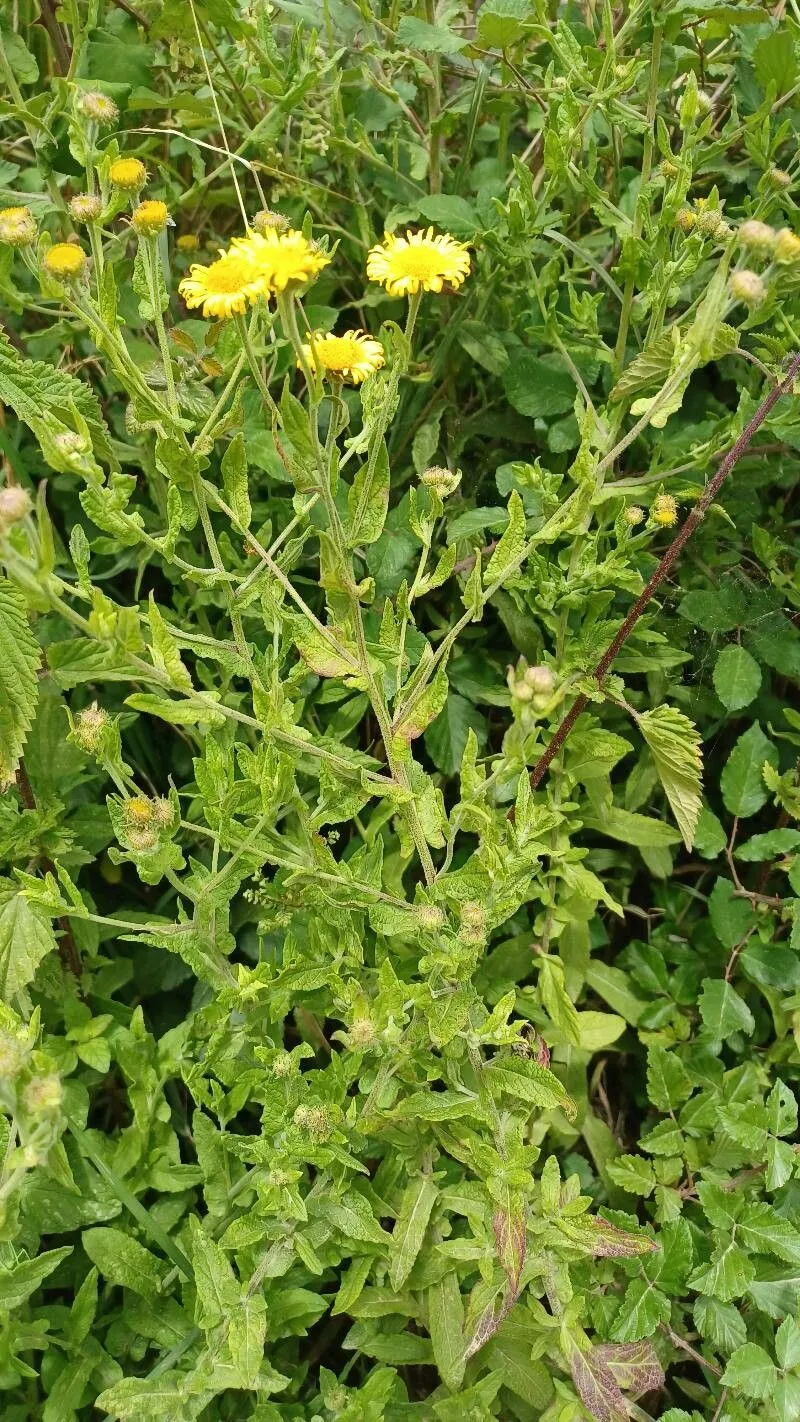
Author: (L.) Bernh.
Bibliography: Syst. Verz.: 153 (1800)
Year: 1800
Status: accepted
Rank: species
Genus: Pulicaria
Vegetable: False
Observations: Europe to C. Asia and W. Himalaya
Common fleabane, scientifically known as Pulicaria dysenterica, is a notable member of the diverse Asteraceae family. This perennial herb is revered for its distinctive characteristics and historical significance across its native range, which extends from Europe to Central Asia and the Western Himalayas.
First officially documented in “Syst. Verz.” in 1800 by the botanist (L.) Bernh., Common fleabane has since captured the interest of botanists and nature enthusiasts alike, largely due to its unique attributes and widespread availability. Its natural habitat often includes meadows, marshlands, and along riverbanks, where it thrives in moist or damp soil conditions, contributing to the biodiversity and ecological balance of these areas.
Common fleabane typically reaches a height of 30 to 90 centimeters, adorned with dense, greyish-green leaves and numerous bright yellow, daisy-like flowers. These flowers, which bloom from mid-summer to early autumn, not only add a splash of color to the landscape but also play a crucial role in supporting local pollinator populations, including bees and butterflies.
Beyond its ecological contributions, Pulicaria dysenterica has a storied past in traditional medicine. Historically, it was believed to possess medicinal properties that could aid in treating dysentery and other gastrointestinal ailments, a fact that is echoed in its scientific name. While its use in modern herbal medicine may be less common, the plant’s historical context provides a fascinating glimpse into early botanical practices and the evolving understanding of herbal therapeutics.
In summary, Common fleabane (Pulicaria dysenterica) stands as a testament to the rich botanical heritage and ecological importance of the Asteraceae family. Its vibrant flowers, along with its historical and geographical significance, continue to make it a subject of interest for botanists, ecologists, and historians alike.
En: Common Fleabane, Meadow false fleabane
Az: Dizenteriyalı pulikariya
Bg: Блъшница
Ca: Herba de Sant Roc
Zh: 止痢蚤草
Kw: Hwannles
Cs: Blešník úplavičný
Nl: Heelblaadjes
Eo: Pulikario kontraǔdisenteria
Fi: Vanukirppuruoho
Fr: Pulicaire dysentérique
Gl: Herba do gato
De: Großes Flohkraut, Ruhr-Flohkraut, Ruhrwurz
He: פרעושית משלשלת
Hu: Mezei bolhafű
Gv: Bossan jargan
No: Strandloppeurt
Pl: Płesznik czerwonkowy
Pt: Erva-das-disenterias, Erva-de-São-Roque
Ru: Блошница дизентерийная
Sk: Blšník červienkovitý
Es: Hierba de Gato
Cy: Cedowydd
Deu: großes flohkraut, ruhr-flohkraut, ruhrwurz
Eng: meadow false fleabane, common fleabane, fleabane
Dan: strand-loppeurt
Nld: heelblaadjes
Fra: pulicaire dysentérique
Swe: strandloppört, strandkrissla
Cym: cedowydd, cedowydd cyffredin, cedowys cyffredin, chweinlys
Taken Aug 23, 2021 by Diego Alex (cc-by-sa)
Taken Jun 24, 2022 by Alain Lagrave (cc-by-sa)
Taken Jun 9, 2022 by ana Hergueta (cc-by-sa)
Taken Jul 16, 2022 by Emre Karaca (cc-by-sa)
Taken Jul 1, 2022 by Gaël Herve (cc-by-sa)
Taken Jun 9, 2022 by ana Hergueta (cc-by-sa)
Taken Sep 7, 2021 by Ross E.F. (cc-by-sa)
Taken Aug 29, 2021 by Nico Nico (cc-by-sa)
Taken Jul 1, 2022 by Gaël Herve (cc-by-sa)
Taken Jul 1, 2022 by Gaël Herve (cc-by-sa)
Taken Aug 30, 2021 by Irène MARIETTE (cc-by-sa)
Taken Aug 16, 2022 by Alona T (cc-by-sa)
Taken Aug 6, 2007 by Rinusz (cc-by-sa)
Taken Aug 9, 2021 by christophe gorla (cc-by-sa)
Taken Jul 1, 2022 by Gaël Herve (cc-by-sa)
© copyright of the Board of Trustees of the Royal Botanic Gardens, Kew.
© copyright of the Board of Trustees of the Royal Botanic Gardens, Kew.
Taken Sep 13, 2021 by Daniela Cortes (cc-by-sa)
Growth habit: Forb/herb
Ph maximum: 8.0
Ph minimum: 7.5
Light: 8
Atmospheric humidity: 8
Bloom months: [‘jul’, ‘aug’, ‘sep’]
Soil nutriments: 6
Family: Myrtaceae Author: (F.Muell.) K.D.Hill & L.A.S.Johnson Bibliography: Telopea 6: 402 (1995) Year: 1995 Status:…
Family: Rubiaceae Author: Pierre ex A.Froehner Bibliography: Notizbl. Bot. Gart. Berlin-Dahlem 1: 237 (1897) Year:…
Family: Sapindaceae Author: Koidz. Bibliography: J. Coll. Sci. Imp. Univ. Tokyo 32(1): 38 (1911) Year:…
Family: Asteraceae Author: A.Gray Bibliography: Pacif. Railr. Rep.: 107 (1857) Year: 1857 Status: accepted Rank:…
Family: Fabaceae Author: Medik. Bibliography: Vorles. Churpfälz. Phys.-Ökon. Ges. 2: 398 (1787) Year: 1787 Status:…
Family: Aspleniaceae Author: (Cav.) Alston Bibliography: Bull. Misc. Inform. Kew 1932: 309 (1932) Year: 1932…